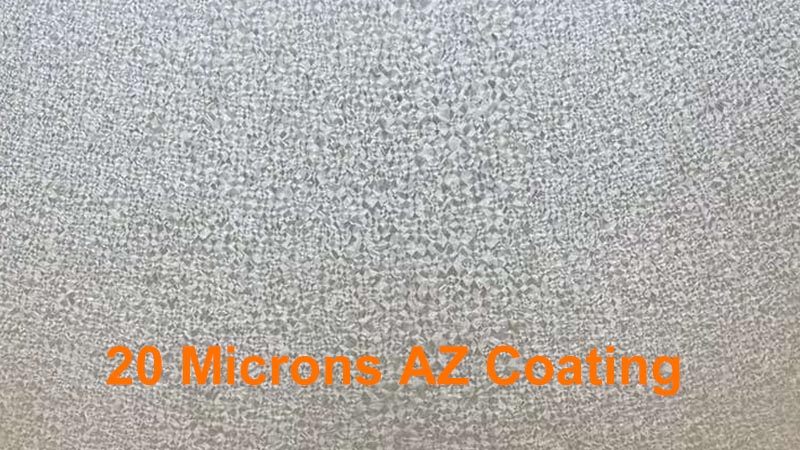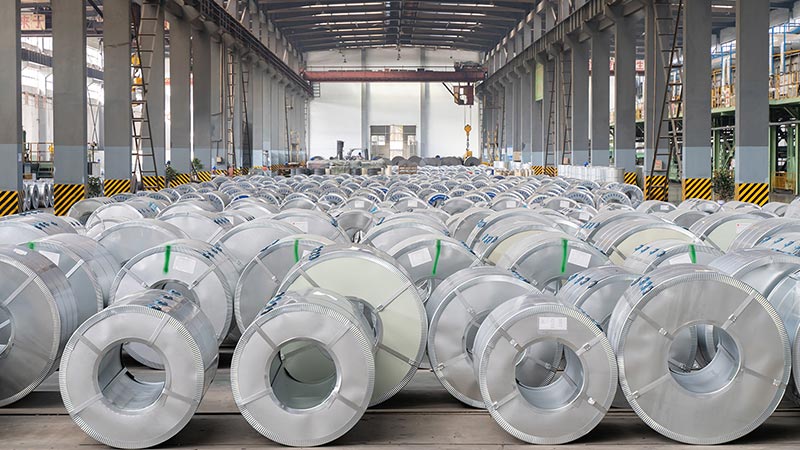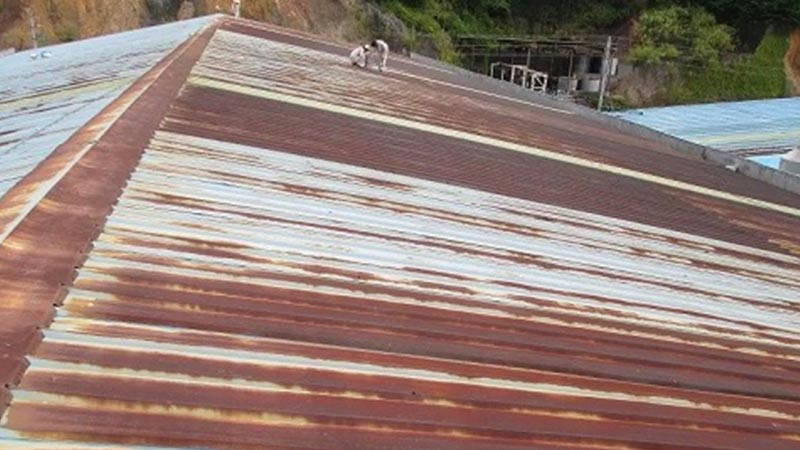


Service life: The design service life of aluminum zinc coated steel plates is usually 20-25 years or more. Under standard atmospheric conditions, its corrosion resistance life is 2-6 times that of ordinary galvanized steel plates.
The relationship between corrosion amount and time is not a simple linear relationship. In the vast majority of atmospheric environments, the corrosion process follows the "power function law", which means that the initial corrosion is faster, followed by a long-term stable and extremely slow corrosion stage.
Key mechanism: The protection of aluminum zinc plating is a "dual protection" mechanism: barrier protection of aluminum and sacrificial protection of zinc.
detailed analysis

Aluminum zinc alloy coating (usually composed of 55% aluminum, 43.4% zinc, 1.6% silicon) combines the advantages of aluminum and zinc:
The function of aluminum: Aluminum forms a dense and stable protective film of aluminum oxide (Al₂O3) on the surface of the coating. This film has excellent resistance to atmospheric corrosion, especially to sulfides and heat, providing excellent barrier protection.
The role of zinc: The electrode potential of zinc is more negative than that of iron. When the coating is scratched or has a cut that exposes the steel substrate, zinc acts as a sacrificial anode and is preferentially corroded, thereby protecting the underlying steel substrate.
The function of silicon: Silicon is mainly used to suppress the excessive alloying reaction between aluminum and iron in the coating during processing, making the coating more flexible and adhesive.
This synergistic effect makes the protective ability of aluminum zinc coating on cutting edges much better than that of pure aluminum coating, and its overall corrosion resistance is much better than that of pure zinc coating.

The relationship between corrosion depth (or weight loss) and time is usually described by the following formula:
D = A * Tⁿ
D: Corrosion depth (µ m) or corrosion weight loss per unit area (g/m²)
T: Exposure time (year)
A and n: constants related to environmental corrosiveness.
For aluminum zinc coated steel plates, this relationship can be more intuitively divided into three stages:
a) Initial stage (1-2 years after exposure)
Characteristic: The corrosion rate is relatively fast.
Reason: The natural oxide film on the surface of the coating is forming and stabilizing. The zinc component in the coating will corrode slightly on the surface, generating corrosion products such as basic zinc carbonate, which will fill the micro pores of the coating and form a denser and more stable protective layer together with the aluminum oxide film.
b) Stable stage (from year 2 to coating depletion)
Characteristic: The corrosion rate becomes very slow and basically constant. This is a crucial stage for aluminum zinc coated steel plates to leverage their longevity advantages.
Reason: A dense and stable protective layer of corrosion products has been fully formed, greatly blocking the penetration of corrosive media (water, oxygen, chloride ions, sulfur dioxide, etc.) into the interior. The barrier effect of aluminum dominates, while the sacrificial corrosion of zinc only occurs slowly at localized damage sites.
c) Failure stage (after coating depletion)
Characteristic: The corrosion rate increases sharply.
Reason: When the coating is completely corroded and consumed, the steel substrate begins to be exposed. Without the barrier and sacrificial protection of the coating, the steel substrate will rapidly corrode at its own corrosion rate.
Galvanized (GI): The curve is steeper and the slope is greater, indicating a higher average corrosion rate throughout its entire lifecycle.
Aluminum zinc plating (55% Al Zn): After a slight increase in the initial stage, the curve becomes very flat, indicating that its long-term corrosion rate is extremely low.
The specific service life of aluminum zinc coated steel plates is not a fixed value, but mainly depends on the following factors:
C1/C2 (low corrosive environment, such as dry indoor environment): The lifespan can reach more than 50 years.
C3 (medium corrosive environment, such as urban atmosphere and low pollution cities): The lifespan is about 20-30 years. This is the most common application environment.
C4 (highly corrosive environment, such as industrial areas and coastal regions): The lifespan is about 15-25 years. Chloride ions (coastal areas) and sulfides (industrial areas) can accelerate corrosion.
C5 (extremely corrosive environment, such as chemical plants, high salinity coastal areas): The lifespan will be significantly shortened and may require thicker coatings or additional protection.
The coating thickness is a direct parameter that determines the lifespan. The coating weight of standard aluminum zinc coated steel plates is usually 60-150 g/m² (double-sided total). The thicker the coating, the more "inventory" of zinc and aluminum, and the longer it takes to consume them into the steel substrate.
Experience estimate: In C3 environment, a coating thickness of 10 grams per square meter can provide approximately 1 year of corrosion resistance life. For example, a coating of 75 grams per square meter is expected to have a lifespan of approximately 7.5 years (until red rust appears). But thanks to the barrier effect of aluminum, the actual service life is much longer than this simple estimate.
Most aluminum zinc coated steel plates will undergo painting (color coated plates) or other chemical passivation treatments. This organic coating or passivation film can greatly extend its lifespan because it directly isolates the corrosive medium from contact with the metal coating.
The essence of the relationship: The corrosion amount of aluminum zinc plating shows a non-linear relationship with time, following the rule of "faster in the early stage and extremely slow in the long term", thanks to its unique aluminum zinc synergistic protection effect.
Estimated lifespan: Under standard C3 environment, the design service life of bare boards (unpainted) can easily exceed 20-25 years. If protected by painting, the total lifespan can reach 40-50 years or even longer.
Select the appropriate coating thickness and surface treatment method based on the specific application environment.
In harsh environments such as coastal or industrial areas, thicker coatings should be preferred, and it is strongly recommended to use color coated panels with high-performance paint systems.
The life prediction chart based on a large amount of outdoor exposure test data provided by the reference supplier is the most accurate basis.
I hope this detailed analysis can help you better understand the corrosion resistance of aluminum zinc materials.
 English
English